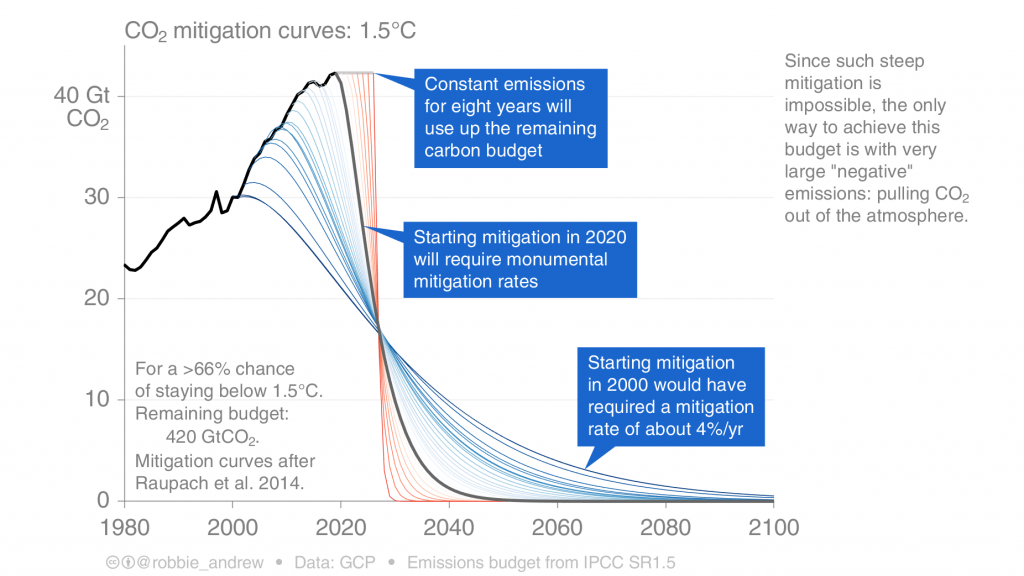Updated on 2021-09-15 by Adam Hardy
When student climate striker Greta Thunberg talks about “simple maths”, she means the carbon budget and how the 2015 Paris Climate Accord (and a normal 2050) is impossible under current policies.
I personally don’t believe Paris 2015 is out of reach, because there are still so many possibilities of what might happen over the next few years.

But what is the carbon budget and what does its simple maths tell us? It is certainly a budget, but it’s not really carbon that it refers to – what’s on the budget is CO2, or more precisely, the amount of CO2 in the Earth’s atmosphere.
The Carbon Clock from the Mercator Research Institute on Global Commons and Climate Change (MCC) in Berlin:
So who gave the world a carbon budget, and what happens if we humans blow our budget, like typical students learning how to cope with our personal finances away from home for the first time in an exciting and distracting new environment? Or what happens if we manage to stick to it?
The climatologists invented the carbon budget as a way of clarifying the complexity of their science for policy- and decision-makers. It’s based on the targets set by the 2015 Paris Climate Accord. This gave society a definitive goal – actually two goals: the main goal is to keep the rise in the average global temperature from pre-Industrial levels below 2°C (3.6°F) and a ‘stretch’ goal of below 1.5°C (2.7°F).
Because of the way global warming works, climatologists can calculate quite precisely the temperature change caused by changes in the CO2 concentration in the atmosphere. Out of that number comes the carbon budget. If we want to hold on to our dream of a ‘normal’ beautiful world in 2050 or 2100, we need to hit that 2015 Paris stretch goal of 1.5°C.
That means society can emit no more than 420 gigatonnes of CO2 (GtCO2) from now on. That’s the budget. Once it’s gone, it’s gone.
But unlike the poor students who have to try to make their money last, society is already using up that budget really fast, pumping out gigatonnes of CO2 at the greatest rate ever. Human-caused CO2 emissions are currently 40Gt per year. The carbon budget will be gone by 2028.
That means we either just shut down the fossil fuel industry completely, or we face up to a nasty future. That’s the simple maths that Greta Thunberg is talking about. Like James Lovelock though, many people in business and government and those who trust their opinions believe we can seek our salvation in some as-yet uninvented huge scale CO2 capture technologies or geo-engineering projects.
This would require huge amounts of energy to pull all the extra CO2 out of the atmosphere to save the carbon budget, for instance it’s not too fantastic to imagine the Sahara covered in solar farms feeding massive CO2 harvesters.
The Carbon Budget Chart
Here is the chart from the Stockholm CICERO climate research centre. The black line is the rising global CO2 emissions per year up until 2018, at which point the chart was drawn. The line’s steep drop shows how the fossil fuel industry would have to cut right back on output over the next several years – and the red curves show how steep the drop can get if we delay action any longer.
This explanation of the carbon budget is a huge simplification. It excludes the probability that the Earth’s climate system will actually do what the climatologists predict it will do. The video from Rod Oram below explains succinctly how this probability affects the budget.
This is the Carbon Tracker source for all of that data:
Lastly, here is the link to the UN IPCC (the top international body on climate science) who produced a huge review of all the science and its policy implications regarding the 1.5°C carbon budget in 2018 – for number-lovers.





One reply on “The Carbon Budget Made Simple”
Glen Peters of Cicero on the problems people have with carbon budgets.
https://cicero.oslo.no/no/posts/klima/beyond-carbon-budgets